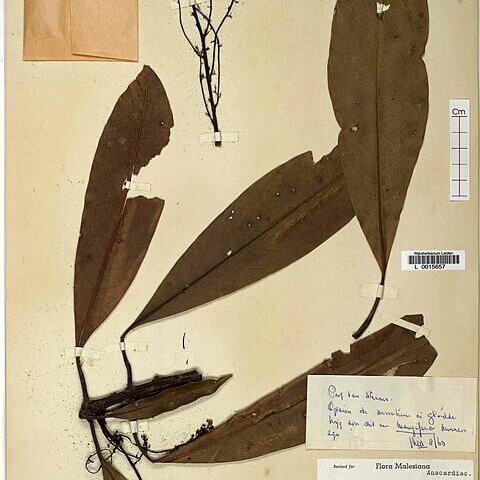Tree 12-35(-54) m high and 35-80(-100) cm Ø. Bark dark brown, smooth; branchlets angular with prominent leaf-scars. Leaves subcoriaceous or coriaceous, elliptic to narrowly elliptic, or oblanceolate, (5-)15½-43 by (2-)3½-H cm; base cuneate or attenuate; apex acute to acuminate, mucronate, or obtuse; nerves (10-) 16-23 pairs, slightly elevated on both surfaces, sometimes more prominent beneath; veins reticulate, distinct beneath and faint above; petiole 1½-5(-9) cm, slightly biconvex near the base of blade, or flat above. Panicles terminal, sometimes also in the apical leaf axils, crowded at the apex of twigs, pyramidal, sometimes seemingly fasciculate, 10-25 cm long, sparsely puberulous, glabrescent; lateral branches up to 14 cm long; floral bracts triangular, 1-1½ mm long; pedicels ⅔-1¼ mm. Flowers white or cream-white, fragrant. Calyx 4-lobed, lobes ovate or ovate-oblong, 2½-3 mm long, sparsely puberulous outside, glabrescent, or glabrous. Petals 4, ovate-oblong, or elliptic, 3½-5 by 1½-2 mm; ridges (3-)5, ½-3f5 the length of petals, confluent at the lower ⅔. Disk pulvinate and concave above, or short-cupular, ⅔-1 mm high, 1½-2¼ mm wide, 4-lobed and papillose. Stamens 5, 1 fertile, 2-3 mm; filaments free; anthers oblong, c. ¾ mm long; staminodes up to ¾ mm. Ovary subglobose, 1-1¼ mm ø; style 2-3 mm, excentric. Sterile pistil in ♂ ⅔ mm. Drupe (fresh) (WESTER, l.c.) green to yellowish, semireniform, ellipsoid, or ovoid, 5½-8 by 4-6 cm; flesh fibrous, resinous, acid. Seed not labyrinthine.
More
A large tree. It grows 12-35 m tall or taller. The trunk is 35-80 cm across or wider. The small branches are angular with prominent leaf scars. The leaves are long and narrow and pointed at both ends or wedge shaped at the base. They are 15-43 cm long by 2-11 cm wide. They are rough. They are dark green above. The flowers are small and white. They have a smell. They are produced in large numbers on branched compound flowers. The veins are net like. The leaf stalk is 1.5-5 cm long. The flowers stalks are crowded near the ends of the twigs. They are 10-25 cm long. The flowers are creamy-white. They occur in groups of 4-5 on side branches. The fruit are 5 to 8 cm long and 4 to 6 cm wide. They are shaped like a mango and are smooth, green and sticky. They turn yellow as they ripen. The flesh is white and fibrous. The stone is 4.5 cm long by 2.5 cm wide and 1 cm thick.

